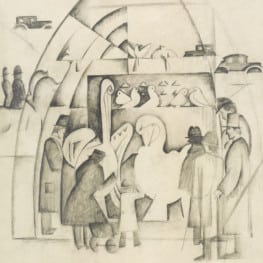William Zorach
1889-1966
Born in Lithuania, William Zorach immigrated with his family to the United States in 1893. Raised in Cleveland, Ohio, he supplemented the family’s meager income by becoming an apprentice in a lithography studio at the age of thirteen. Eventually earning enough money to study painting at the Cleveland School of Art and the National Academy of Design in New York, the budding artist also used his talents as a commercial lithographer to finance a trip abroad in 1910. Selecting Paris as his destination, he attended classes at La Palette, a progressive art school that encouraged the development of a modern aesthetic. Although he was working in an academic style upon his arrival, Zorach soon began experimenting with the techniques of Impressionism and Post-Impressionism that he was encountering in his lessons and at the avant-garde salon exhibitions. Regarding his time in Paris, the artist recalled, “I began to be conscious of the various modern influences that were invading the art world…I was disturbed and confused, and yet I felt that I was a very young man entering a new age. The forces creating modern art seemed more alive to me than anything I had known or anything being done in America.”[1]
Returning to the United States in 1911, Zorach relocated to New York City a year later, where he reunited with and married Marguerite Thompson, a fellow artist with whom he had fallen in love in Paris. Working side-by-side, the two investigated similar formal concerns of color, design and compositional rhythm, producing brilliantly hued images of nudes and lovers reposing in Arcadian landscapes. While the couple’s earliest works were characterized by the bold colors and flat patterns of Fauvism, by 1915 they began to incorporate cubist devices into their compositions. William, whose greatest source of inspiration in these years were the forms and creatures of the natural world, rendered expressive landscapes in a personalized cubistic style. Two of the earliest proponents of modernism in New York, William and Marguerite mounted exhibitions in their small Greenwich Village apartment in addition to contributing paintings to the seminal Armory Show of 1913 and the Forum Exhibition held in 1916.
Although trained as a painter, William Zorach began experimenting with the creation of sculpture while residing in New Hampshire during the summer of 1917. Working exclusively in wood until 1921 when he began carving stone, the artist eventually became one of the most prominent practitioners of direct carving in America. Cutting into a piece of stone or wood without a definitive, pre-formulated design, he “discovered” the composition of the work as it gradually emerged during the carving process. Inspired by themes of a more traditional nature, Zorach conveyed his vision of earthly and universal love through the sculptural forms of mother and child groups, nude female figures and portrait heads. In addition, he found great delight in modeling the forms of cats, dogs and various undomesticated animals that were part of the natural surroundings at his home in Maine.
[1] William Zorach, Art is My Life (New York and Cleveland: The World Publishing Company, 1967), p. 22.

